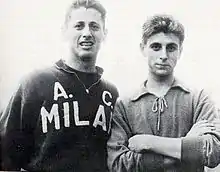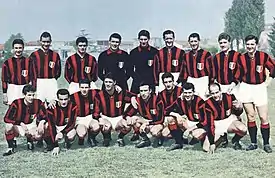Juan Alberto Schiaffino
Juan Alberto "Pepe" Schiaffino Villano (Italian pronunciation: [skjafˈfiːno]; 28 July 1925 – 13 November 2002)[2] was an Italian-Uruguayan football player who played as an attacking midfielder or forward. A highly skilful and creative playmaker, at club level, he played for CA Peñarol in Uruguay, and for A.C. Milan, and Roma in Italy. At international level, he won the 1950 FIFA World Cup with the Uruguayan national team, and also took part at the 1954 FIFA World Cup; he later also represented the Italy national football team.[1][3][4][5][6]
 Juan Alberto Schiaffino and Gianni Rivera in 1960 | |||||||||||||
| Personal information | |||||||||||||
|---|---|---|---|---|---|---|---|---|---|---|---|---|---|
| Full name | Juan Alberto Schiaffino Villano | ||||||||||||
| Date of birth | 28 July 1925 | ||||||||||||
| Place of birth | Montevideo, Uruguay | ||||||||||||
| Date of death | 13 November 2002 (aged 77) | ||||||||||||
| Height | 1.85 m (6 ft 1 in)[1] | ||||||||||||
| Position(s) | Attacking Midfielder/Forward | ||||||||||||
| Senior career* | |||||||||||||
| Years | Team | Apps | (Gls) | ||||||||||
| 1943–1954 | Peñarol | 227 | (88) | ||||||||||
| 1954–1960 | Milan | 149 | (47) | ||||||||||
| 1960–1962 | Roma | 39 | (3) | ||||||||||
| Total | 415 | (138) | |||||||||||
| National team | |||||||||||||
| 1946–1954 | Uruguay | 21 | (9) | ||||||||||
| 1954–1958 | Italy | 4 | (0) | ||||||||||
| Teams managed | |||||||||||||
| 1974–1975 | Uruguay | ||||||||||||
| 1975–1976 | Peñarol | ||||||||||||
Honours
| |||||||||||||
| * Senior club appearances and goals counted for the domestic league only | |||||||||||||

He was ranked as the best Uruguayan footballer of all time by an IFFHS poll, and the 17th greatest player of the twentieth century.[7]
Club career
Following his eight successful years in Peñarol in his native Uruguayan league, Schiaffino was purchased by Italian Serie A club A.C. Milan, for an at the time world record fee of 52 million Lire, in September 1954.[4] He played 171 games with A.C. Milan and scored 60 goals, and participated in the 1958 European Cup Final, which Milan lost to Real Madrid 2–3 (aet). He was among the crucial offensive players in a Milan team that was dominated by foreign stars such as Nils Liedholm and Gunnar Nordahl. Schiaffino won three national championships with Milan, the victories being in 1955, 1957 and 1959.[8] Schiaffino left in 1960 to join Roma, where he played out his career during two moderately successful seasons, in which Roma finished fifth in the standings.[4]
International career
Schiaffino played for two national teams; first with the Uruguyan national team from 1946 to 1954, and later with the Italian national team from 1954 to 1958, courtesy of his paternal grandfather who was a Ligurian from the province of Genoa.[4]
He obtained 21 caps with the Uruguyan national team, scoring nine goals, and four caps with the Italian national team.
Schiaffino participated actively in Uruguay's victory in the 1950 World Cup, scoring one goal in the final and beating Brazil in its own stadium, in what was called the Maracanazo. He also played in the 1954 World Cup, helping his nation to a fourth-place finish in the tournament.[8]
Style of play
A tactically versatile player, with a slender physique, Schiaffino was usually deployed as a left-sided inside forward or second striker in the early part of his career, in particular with CA Peñarol and A.C. Milan, or as an attacking midfielder, although he was also capable of playing as a deep-lying playmaker in midfield, a role which he occupied more frequently as his career progressed. Schiaffino was renowned for his creative ability and for having a unique capacity to read the game, organise his teammates, orchestrate goalscoring opportunities, and dictate the tempo of his team's play in midfield, which made him a highly proficient playmaker and assist provider; as a footballer, he was best known for his excellent technical ability, passing range, intelligence, positional sense, leadership, and vision. A well-rounded and hard-working player, who is regarded by pundits as one of the greatest footballers of all time, in addition to his skill, elegance, and creativity on the ball, Schiaffino was also known for his defensive contribution and willingness to track back, put pressure on opponents, and challenge them for the ball, often with sliding tackles; his wide range of skills also enabled him to play as a sweeper with Roma in his later career.[1][3][4][5][6][9]
Death
Schiaffino died on 13 November 2002. His remains are buried at the Cementerio del Buceo, Montevideo.[10]
Honours
Club
- Primera División Uruguaya (Uruguayan championship): 1949, 1951, 1953, 1954
Individual
- FIFA World Cup All-Star Team: 1950[12]
- IFFHS Uruguayan Player of the 20th Century[7]
- IFFHS South American Player of the 20th Century (6th place)[7]
- IFFHS Player of the 20th Century (17th place)[7]
- World Soccer: The 100 Greatest Footballers of All Time[13]
- A.C. Milan Hall of Fame[11]
- IFFHS Legends[14]
References
- "Schiaffino Juan Alberto" (in Italian). Enciclopedia del Calcio. Retrieved 24 May 2016.
- "Murió ayer el ex futbolista uruguayo, Juan Schiaffino". El Siglo de Torreón. 14 November 2002. Retrieved 6 March 2009.
- http://www.xtratime.org/forum/showthread.php?t=246965
- Sebastiano Vernazza (14 November 2002). "Addio geniale Schiaffino" (in Italian). La Gazzetta dello Sport. Retrieved 18 January 2015.
- Fabio Bianchi; Gaetano Imparato; Alberto Cerruti (14 November 2002). "Aveva il senso della squadra" (in Italian). La Gazzetta dello Sport. Retrieved 24 September 2017.
- "Juan Alberto SCHIAFFINO" (in Italian). www.magliarossonera.it. Retrieved 24 September 2017.
- "IFFHS' Century Elections".
- "Schiaffino, legend on two continents". FIFA.com. 15 February 2012.
- Martini, Davide (3 August 2016). "I migliori stranieri over 30 della storia della Serie A: Guardiola, Evra, Rummenigge ed altri!" (in Italian). www.90min.com. Retrieved 6 October 2019.
- "Farewell to a big one" (in Spanish). LR21. 15 November 2002.
- "A.C. Milan Hall of Fame: Juan Alberto Schiaffino". acmilan.com. Retrieved 1 April 2015.
- "FIFA World Cup All-Star Team – Football world Cup All Star Team". Football.sporting99.com. Archived from the original on 30 June 2016. Retrieved 28 June 2012.
- "World Soccer Players of the Century". World Soccer. Retrieved 29 August 2014.
- "IFFHS announce the 48 football legend players". IFFHS. 25 January 2016. Retrieved 14 September 2016.
External links
| Wikimedia Commons has media related to Juan Alberto Schiaffino. |